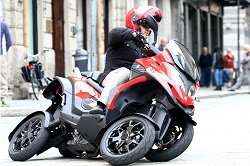
A consortium of 14 partners has developed technology demonstrators for what the compact and efficient electric vehicles of the future could look like. The three light vehicles, developed under the supervision of Piaggio and KTM, anticipate new design approaches for the sector.
Compact electric vehicles (ELVs) may be a cornerstone of the transition towards smart and green mobility in EU cities, but they are not quite ready for mass appeal. Besides a lack of infrastructure, the vehicles themselves are still not convenient enough for use in cities, and they are also restrained by expensive batteries with reduced range and long recharging time. To thrive, the sector needs to reduce production and use costs, as well as provide a more enjoyable experience to drivers.
The ELV prototypes designed under the RESOLVE (Range of Electric SOlutions for L-category VEhicles) project aim to meet these requirements. These four-wheel scooters revolve around low-cost, modular and scalable LV-specific electric powertrains and battery architectures, and they have been designed specifically with urban use in mind.
The prototypes are safer, more dynamic and quicker to recharge thanks to the possibility of easily swapping batteries, require less energy and cost less than existing ELVs. The icing on the cake is that they also include a multi-wheel vehicle control algorithm that improves handling and stability, along with an innovative, user-friendly HMI that addresses ‘range anxiety’.
“The project has delivered an exciting and attractive ELV driving experience by proposing two new concepts of tilting four wheelers (narrow track), while keeping the vehicle energy consumption at a very low level,” explains Serena Fruttaldo, RESOLVE Communication and Dissemination Manager at RE:Lab – one of the project partners in charge of user interface development and dissemination.
The user can easily interact with the vehicle even while moving (via controls on the handlebar), to get real-time information that will help him/her improve the ELV efficiency and riding experience such as regenerative braking and tilt angle. “Besides, our Smart Range Management function allows an active role of the user over the vehicle performance, but ensuring the target destination is reached in any case,” Fruttaldo adds.
Each four-wheeler demonstrator (L2e and L6e category) has its own engine installation, which helped the project team evaluate the pros and cons of each approach. One uses a single powertrain with mechanical differential and final transmission, while the other has two on-wheel powertrains coupled by an e-diff and no transmission. The two approaches resulted in clear advances in terms of functionality, ease of use, dynamic behaviour and safety, although Fruttaldo says that each one brings a different answer to urban mobility challenges.
“We can proudly say that we reached our initial objectives, and even went further with the development of a third prototype to increase our range of solutions. This additional tilting three-wheeler, which is also in the L2e category, has a single powertrain. What it loses in functionality (but not safety), it compensates for with a reduced production cost,” says Fruttaldo.
Now that the project is completed, Fruttaldo expects the technologies developed (batteries, powertrains, HMI, tilting suspension and vehicle dynamics solution) to be ready for commercialisation within the next few years.
